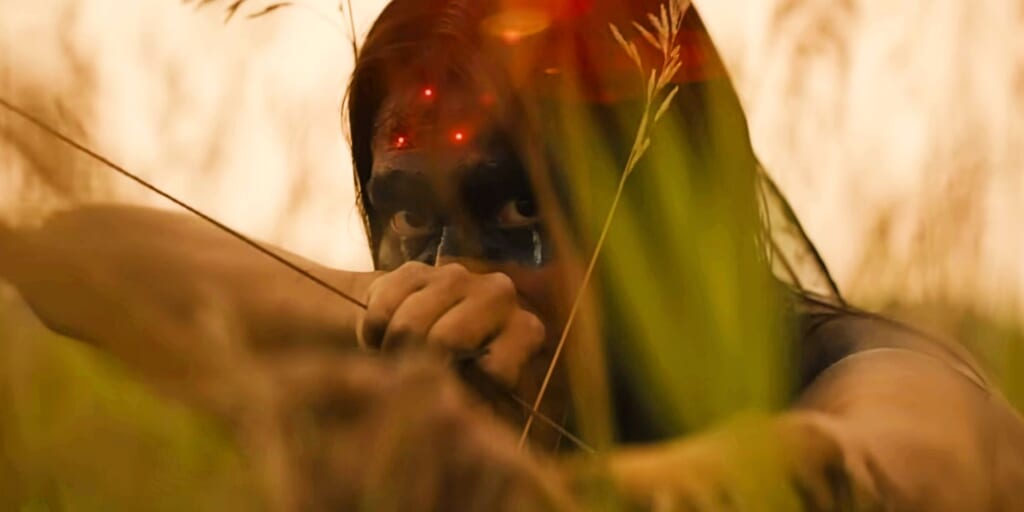Could ‘Prey’ Be the Beginning and the End For the ‘Predator’ Franchise?

Prey has been an undeniable smash hit on streaming for Hulu. Dan Trachtenberg’s prequel has reinvigorated the Predator franchise by going back to basics and staying out of theaters. According to Hulu, Prey is its biggest premiere ever. It even outpaced the debut of the new and improved “reality” show, The Kardashians. Hopefully, there aren’t any internal talks happening to combine the elder sister Kim with the Elder Predator from Predator 2 in a battle for the ages set in Calabasas, California. But that does raise an interesting question. Will the success of Prey result in inferior sequels that wind up hurting the franchise?
For now, the pre-colonial prequel is widely being hailed as the second best Predator movie, falling only to John McTiernan’s 1987 classic. Ingeniously, Prey travels back in time to the early 18th century to highlight a small tribe of the Comanche Nation tracking a mysterious threat. A young warrior named Naru (Amber Midthunder) emerges as the leader guiding her people through a quiet epic set on the Great Plains of a lush and bountiful American landscape. When the Apex Predator (Dane DiLiegro) disrupts the natural order of things, the first encounter humans ever have with the predator race results in some of the best pure action in the franchise to date.
The proto-predator in Prey represents a different kind of North American invasion compared to the pillaging groups of French fur traders and trappers that appear about halfway into the film. The trappers are a purely destructive presence motivated by profit alone. The predator wants domination only if it’s in the name of the hunt. The Comanche have no respect for the French invaders. Through glorious displays of quick disposable violence, it’s clear that the predator doesn’t hold them in high regard either.

Naru and her brother Taabe (Dakota Beavers) both fear and revere the predator as a formidable opponent that has a set of rules. Even if the predator breaks those rules from time to time, the Comanche respect the code. Both sides have a certain set of skills. This allows the hunted to use their experience, ingenuity, and knowledge of the land to outwit and outlast an intergalactic killer. Even when that killer is carrying a flurry of concealed space weapons.
In Predator, Dutch (Arnold Schwarzenegger) is forced to essentially abandon his training as a special ops soldier. Through a series of trap rigging and stealth tactics, Dutch really just winds up getting lucky in the end. When the predator unmasks to show Stan Winston’s creature design and Kevin Peter Hall’s fully alive performance, the true character of the predator is revealed. It’s cocky. Toying with Dutch winds up being its downfall in the end. In Prey, the difference is clear. Apex Predator is consistently challenged and clearly surprised by the Comanche warrior. When it reveals its boned mask and more traditional weaponry, it’s much more ceremonial.
Not surprisingly, the proto-predator grants the most reverence to characters comprised almost entirely of Indigenous and First Nations’ talent. That admiration could serve as a stand-in for our own recognition of the Comanche Nation and other First Nations people. The option to watch the Comanche language dub of Prey on Hulu also reflects a level of respect that other entries in the franchise were not able to do.
Jumping from the Great Plains of 1719 in Prey to the L.A. cityscape of 1990 in Predator 2, an unlikely but clever connection is unearthed. The old flintlock pistol that the Elder Predator hands Mike Harrigan (Danny Glover) is the same handgun given to Naru towards the end of Prey. The engraving on the weapon reads “Raphael Adolini, 1715.” It’s no accident that the translator in Prey who gives Naru the gun is simply named Raphael. The Dark Horse comic Predator: 1718 followed the mystery of the gun revealing Adolini was actually a pirate. Obviously, Prey decided to go another way.
That could be a compelling jumping-off point for a follow-up to Prey. Another could connect Billy Sole (Sonny Landham), the half-Sioux, half-Italian soldier in Predator who took on the creature in hand-to-hand combat. Surely, the impossible story of a female Comanche warrior defeating an unstoppable hunter from another world would have traveled from tribe to tribe. It is, after all, the stuff of legend.
When Dan Trachtenberg originally pitched the idea of Prey, it was already planned to be a storyline that could run alongside any other project in development within the Predator world. In theory, the world of Prey could work tangentially with the Predator mythos. The prequel story could build on the world without derailing the larger property. Now that Prey has firmly placed the Predator franchise back into the cultural spotlight, it may usher in an entirely new direction all its own.
Ideally, Prey would be the perfect bookend. If Trachtenberg stays aboard, maybe he could convince Wyatt Russell to join the fight. Trachtenberg directed “Playtest” starring Russell in one of the better episodes of Black Mirror. Perhaps Trachtenberg could do for Wyatt what John Carpenter did for his father, Kurt. Maybe Prey could be the start of a fantastic series of films, even if it should probably go down as the beginning and the end of the Predator legacy.
-
Prey
Summary
Prey reinvigorates and revitalizes the predator legacy, going back in time to show how the franchise still has a future.
Categorized:Editorials Movie News Reviews
